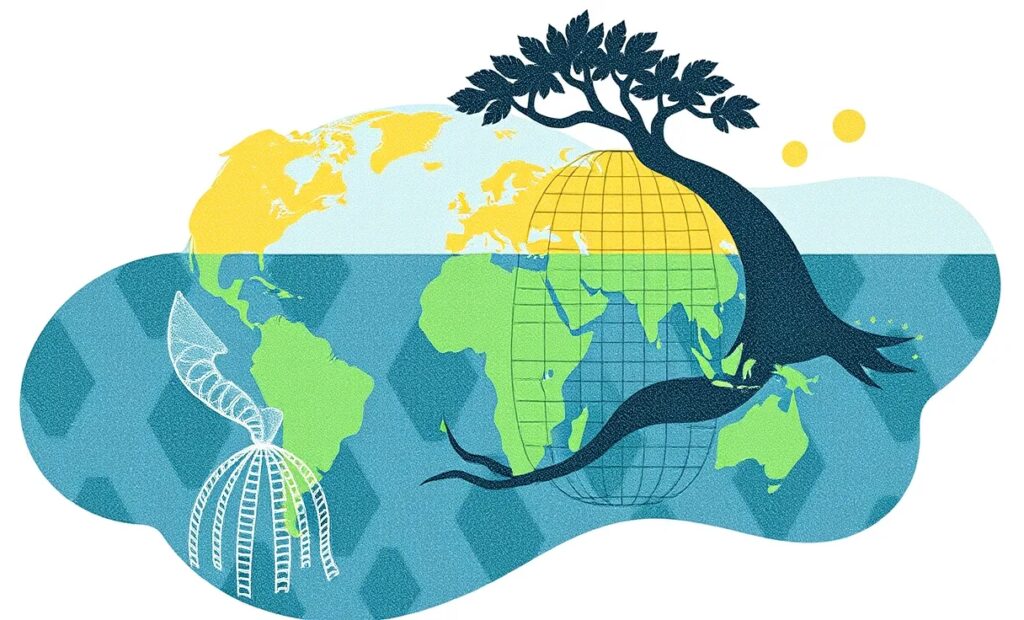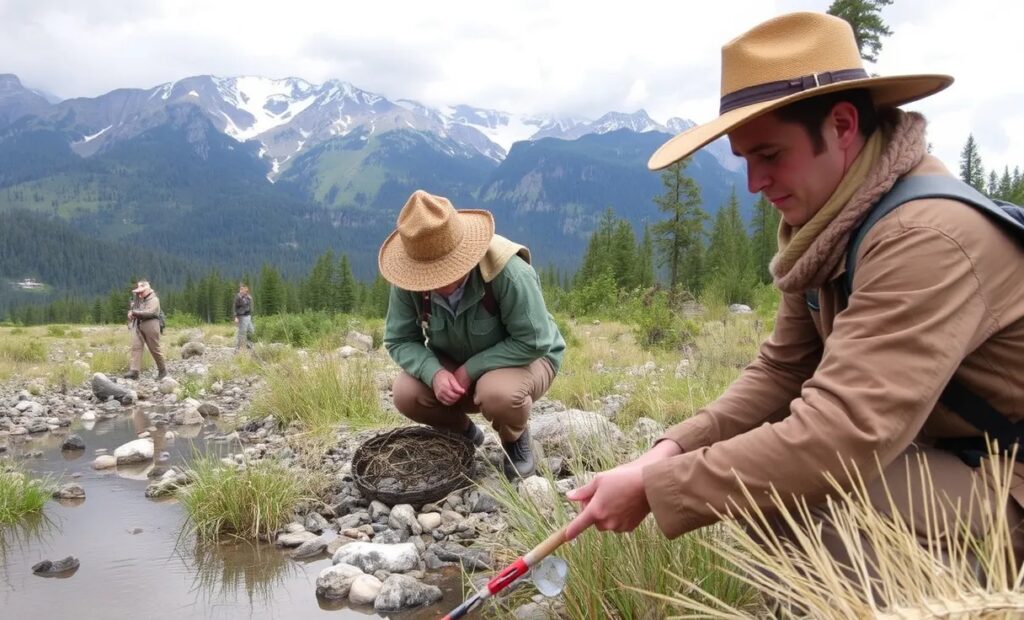
How Adaptive AI is Revolutionizing Conservation
Precision in Tracking Wildlife Populations
Gone are the days of manual counts for estimating wildlife numbers. With adaptive AI, scientists use drones and cameras powered by machine learning to identify and track species more accurately.
These tools analyze patterns in animal behavior and detect even subtle changes in population dynamics.
For instance, AI-driven tools like those employed by the World Wildlife Fund use thermal imaging and pattern recognition to identify endangered species without disturbing them. This means more effective conservation strategies tailored to each species’ needs.
And the best part? These technologies work in real-time, offering quick insights to prevent ecological disasters.
Monitoring Ecosystem Health
Ecosystems are intricate networks, and understanding their health requires vast data. Adaptive AI excels here, processing satellite imagery, weather patterns, and even soil quality data.
Tools like Google’s AI for the Environment monitor deforestation rates, detect illegal logging, and predict areas vulnerable to climate change. AI helps pinpoint causes and solutions faster than human teams ever could.
Plus, adaptive AI can flag problems early—before they spiral into ecological crises.

Fighting Climate Change with AI
Predicting Environmental Shifts
The climate is always changing, but predicting shifts accurately is tough. Adaptive AI tackles this by analyzing years of climate data to model potential future scenarios.
These models help governments and organizations prepare for extreme weather events, flooding, and droughts. For instance, IBM’s Environmental Intelligence Suite predicts hurricanes and their potential damage, aiding disaster preparation efforts.
With AI, it’s no longer about reacting to problems but proactively addressing them.
Reducing Carbon Footprints
Companies use adaptive AI to streamline operations and cut carbon emissions. From optimizing energy usage in factories to creating smart grids for cities, AI helps industries reduce their ecological impact.
Take Google’s DeepMind, which cut energy usage in data centers by 40%. Imagine scaling that across industries—it’s a game-changer for carbon footprint reduction.
Tackling Pollution with AI Technology
Identifying Pollutants in Real-Time
Detecting pollutants before they wreak havoc is crucial. AI-powered sensors monitor air, water, and soil quality in real-time. They identify harmful substances like heavy metals or particulate matter in seconds.
For instance, the AirVisual platform uses AI to deliver accurate air quality data globally, helping cities tackle pollution hotspots. Similarly, AI tools monitor oceans for plastic waste, assisting in targeted cleanup efforts.
Managing Waste Efficiently
AI takes waste management to the next level. Smart sorting systems use adaptive algorithms to identify recyclable materials, minimizing landfill waste.
Cities like Amsterdam employ AI-driven recycling programs that enhance efficiency and encourage sustainable practices. These systems even predict waste trends, ensuring better resource allocation.
Stay tuned for more on AI’s role in restoring ecosystems and its ethical considerations.
AI’s Role in Restoring Ecosystems

Rehabilitating Damaged Habitats
When habitats are degraded, adaptive AI steps in to restore balance. Using machine learning, scientists can analyze the root causes of habitat destruction and develop tailored solutions.
For instance, AI-driven tools assess soil quality and vegetation growth to determine the best reforestation techniques. Organizations like Conservation International use drones powered by AI to plant millions of trees efficiently, aiding habitat recovery.
This tech ensures that reforestation efforts succeed, even in challenging terrains.
Managing Invasive Species
Invasive species can wreak havoc on ecosystems, often spreading unnoticed. Adaptive AI monitors these threats by analyzing environmental changes and detecting unusual patterns.
For example, AI-powered models predict where invasive plants or animals might thrive, allowing for early intervention. This proactive approach prevents these species from overtaking native populations.
Reviving Biodiversity Hotspots
Biodiversity hotspots are critical for the planet’s health. AI tools help map these areas, identifying species at risk and prioritizing them for conservation.
Projects like Google Earth Engine analyze satellite imagery to locate critical habitats and areas needing protection. With adaptive AI, every effort becomes more focused and impactful.
Ethical Considerations in AI for Conservation
Balancing Technology with Nature
While adaptive AI offers immense benefits, its use must be carefully managed. Over-reliance on technology can risk neglecting traditional conservation methods that have worked for centuries.
Striking a balance ensures that indigenous knowledge and modern AI complement rather than replace one another.
Data Privacy Concerns
Conservation often involves gathering extensive data, including images and locations. Ensuring this information doesn’t compromise sensitive areas—or fall into the wrong hands—is crucial.
Organizations must adopt strict data security measures to protect ecosystems and species from exploitation. Transparency about data usage can build public trust in AI-driven initiatives.

Collaborative Efforts in Conservation Tech
Partnerships Between Tech and Conservationists
Tech companies are teaming up with conservationists to create impactful solutions. These collaborations combine cutting-edge AI with boots-on-the-ground expertise.
For example, Microsoft’s AI for Earth initiative funds projects worldwide, tackling issues like water scarcity and wildlife monitoring. Such partnerships drive innovation and widen AI’s reach in protecting the environment.
Engaging Communities with AI
Community involvement is vital for conservation success. Adaptive AI tools are now accessible to local groups, empowering them to monitor and protect their ecosystems.
By training communities to use drones and AI-powered apps, they become active participants in saving their natural surroundings. This democratization of technology fosters sustainable stewardship.
Adaptive AI has already begun transforming how we protect and restore our planet. As its potential continues to unfold, collaboration and ethical practices will be key to ensuring it benefits both humans and nature.
The Future of Adaptive AI in Environmental Conservation
Scaling Solutions for Global Impact
Adaptive AI has the power to address global environmental challenges at scale. By automating data collection and analysis, these tools accelerate efforts to combat deforestation, climate change, and pollution.
Initiatives like UNEP’s AI and Big Data Program use AI to aggregate global environmental data, creating actionable insights for policymakers. Scaling such solutions ensures every country can access cutting-edge tools for conservation.
The ultimate goal? A globally coordinated response to environmental crises, powered by adaptive technology.
Innovations on the Horizon
The next generation of adaptive AI will integrate advanced robotics, quantum computing, and bioinformatics to revolutionize conservation further. Imagine drones with AI-driven precision planting that optimize soil conditions for every seed or sensors that detect minute ecosystem imbalances long before they become problems.
Emerging technologies will make it easier to track migrating species, monitor fragile ecosystems, and forecast long-term environmental changes with unprecedented accuracy.
AI and the Circular Economy
Adaptive AI plays a critical role in moving toward a circular economy, where waste is minimized, and resources are reused. AI systems are already helping industries recycle efficiently, design sustainable products, and reduce excess production.
For example, companies like Circularity Informatics Lab use AI to optimize material reuse in manufacturing. These innovations reduce waste while promoting economic and environmental sustainability.
The Human Role in an AI-Driven World
Complementing Human Efforts
AI may excel at data processing and prediction, but it can’t replace human intuition and compassion. Conservation efforts must continue to prioritize the expertise and dedication of researchers, activists, and local communities.
By combining human insights with AI’s precision, we achieve the best outcomes for the planet.
Building a Sustainable Future Together
As individuals, we can support these advancements by advocating for ethical AI use, staying informed, and contributing to conservation programs.
The future of environmental monitoring and conservation is brighter with adaptive AI at its core. Together, we can create a sustainable world where technology and nature coexist harmoniously.
Final Takeaways
Adaptive AI is undeniably transforming the landscape of environmental monitoring and conservation. From tracking endangered species to restoring biodiversity, these technologies amplify human efforts and address challenges at an unprecedented scale.
However, the integration of AI into conservation must be approached thoughtfully, with ethical practices and global collaboration at the forefront. Balancing innovation with traditional methods and community engagement ensures that these advancements benefit both people and the planet.
By embracing adaptive AI’s potential and working together, we can protect Earth’s ecosystems for generations to come.
FAQs
Is adaptive AI accessible to local communities?
Yes, many AI tools are becoming more user-friendly and accessible. For instance, conservation groups train local communities to use AI-powered apps and drones to monitor their ecosystems.
Projects like EarthRanger allow rangers in remote areas to track wildlife and prevent poaching using easy-to-navigate dashboards. These technologies empower communities to take ownership of conservation efforts.
Are there risks involved in using AI for conservation?
While AI offers numerous benefits, there are some concerns, including data privacy and over-reliance on technology. For instance, sensitive data about endangered species’ habitats could be misused if not properly secured.
Additionally, neglecting traditional conservation methods in favor of AI could sideline indigenous knowledge, which has long played a vital role in protecting ecosystems. Ethical practices and balanced approaches are essential to mitigate these risks.
How does adaptive AI assist with invasive species management?
Adaptive AI detects and predicts the spread of invasive species by analyzing environmental data and spotting unusual trends. For instance, AI models have been used to monitor the spread of the invasive lionfish in the Atlantic, helping conservationists plan targeted removal efforts.
Additionally, machine learning algorithms predict which ecosystems are most at risk, allowing proactive interventions that save native species and habitats.
Can adaptive AI restore degraded ecosystems?
Yes, AI plays a significant role in ecosystem restoration. For example, adaptive AI algorithms guide reforestation efforts by determining the best species to plant based on soil health and climate conditions.
Organizations like Dendra Systems use AI-powered drones to plant trees in damaged areas, achieving rapid reforestation on a massive scale. These targeted methods make restoration efforts highly effective.
How does AI balance technological innovation with traditional conservation methods?
Adaptive AI complements rather than replaces traditional methods. For instance, while AI monitors wildlife populations via camera traps, indigenous communities provide valuable insights into species behavior and habitat conditions.
A successful example is the partnership between WWF and AI researchers, where local knowledge combined with AI tools led to better protection strategies for endangered tigers in India.
Does adaptive AI contribute to waste management?
Indeed, AI is revolutionizing waste management. Smart sorting systems powered by machine learning identify recyclable materials with greater precision, reducing landfill waste.
Cities like San Francisco have implemented AI-powered recycling programs that analyze waste streams, boosting recycling rates and reducing environmental impact.
How is adaptive AI ensuring ethical practices in conservation?
Adaptive AI frameworks are being designed with transparency and fairness in mind. For instance, conservation programs now integrate open-source AI tools, ensuring inclusivity and avoiding biases in data interpretation.
Additionally, organizations like Microsoft AI for Earth emphasize ethical data usage, ensuring sensitive information about species or habitats is securely managed. This approach helps build trust and safeguards natural ecosystems.
How does adaptive AI improve water resource management?
Adaptive AI enhances water management by analyzing data from sensors, weather forecasts, and hydrological models. For example, tools like Aqueduct Water Risk Atlas use AI to predict water stress levels in different regions, helping policymakers allocate resources effectively.
Farmers also benefit from AI-powered irrigation systems that optimize water usage based on soil moisture and crop requirements, reducing waste while improving yields.
Can adaptive AI help monitor ocean health?
Absolutely. AI-powered tools are increasingly used to monitor and protect marine ecosystems. For instance, adaptive AI algorithms analyze satellite imagery to track coral bleaching events, providing early warnings to conservationists.
Projects like Ocean Cleanup use AI to map and predict plastic pollution hotspots, guiding targeted cleanup missions and protecting marine life.
Is adaptive AI cost-effective for conservation efforts?
Yes, adaptive AI can reduce costs in the long term by automating labor-intensive tasks and improving the accuracy of conservation strategies. For example, using drones equipped with AI to monitor wildlife eliminates the need for extensive fieldwork, saving time and resources.
Moreover, predictive models help allocate funds more effectively by identifying the most pressing environmental threats. This ensures limited budgets are used wisely.
How does adaptive AI address deforestation?
AI combats deforestation by monitoring forest cover through satellite imagery and detecting illegal activities in real time. For instance, Global Forest Watch uses adaptive AI to send alerts when deforestation occurs, enabling rapid responses by local authorities.
In addition, AI tools assess areas for reforestation, ensuring the right trees are planted in the right locations to restore ecosystems effectively.
What role does AI play in combating climate-related disasters?
AI models predict extreme weather events like hurricanes, floods, and droughts by analyzing historical and real-time climate data. For instance, the NOAA’s AI Weather Prediction Program improves forecasts, giving communities more time to prepare and minimize damage.
These tools also support post-disaster recovery by identifying the most affected areas and guiding resource allocation efficiently.
Resources
Articles and Research Papers
- Global Forest Watch – Explore real-time data on forest changes and deforestation alerts powered by adaptive AI.
- AI for Earth – Microsoft – Learn about initiatives using AI to tackle global environmental challenges.
- Conservation International – Discover how technology supports wildlife and ecosystem conservation.
Tools and Platforms
- EarthRanger: A real-time platform for monitoring wildlife and detecting threats to ecosystems. Visit EarthRanger
- Ocean Cleanup: Combating plastic pollution in oceans using AI-driven mapping tools. Explore Ocean Cleanup
- AirVisual by IQAir: Track air quality globally with AI-powered insights. Check AirVisual
Organizations
- World Wildlife Fund (WWF): Partnering with AI researchers to protect endangered species. Learn More
- United Nations Environment Programme (UNEP): Using AI and big data for global environmental monitoring. Explore UNEP





